
 |
| You might also like: | All About Jewels Glossary: A | All About Jewels Glossary: K | All About Jewels Glossary: J | All About Jewels Glossary: O | All About Jewels Glossary: Z | Today's featured page: House Cats |
| Our subscribers' grade-level estimate for this page: 4th - 6th |
Illustrated Dictionary of Jewelry |
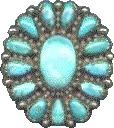 |
||||||
| A | B | C | D | E | F | G | H | I | J | K | L | M | N | O | P | Q | R | S | T | U | V | W | X | Y | Z |
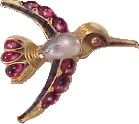 CABOCHON A cabochon is a stone that has a rounded, domed surface with no facets. A cabochon garnet is also called a carbuncle. The Trifari hummingbird pin above has cabochon stones. |
CAIRNGORM Cairngorm is a yellow-brown type of smoky quartz that is often used in traditional Celtic jewelry. Cairngorm is not Scottish topaz. The supply of cairngorm is virtually exhausted, so heat-treated Brazilian amethyst is used as a substitute in Scottish jewelry. |
CALCITE Calcite (Calcium Carbonate, CaCO3) is a very common mineral that comes in a wide variety of forms, shapes and colors. The trigonal crystals range from translucent to transparent. Transparent calcite exhibits a double refraction effect (when you look through the crystal, singel items are doubled). Calcite has a hardness of 3 (most forms), a specific gravity of about 2.7, a refractive index of 1.49 and 1.66, and a white streak. |
CALIBRE-CUT Calibre-cut stones are small stones that are cut into special shapes that are meant for use in commonly-used designs. These stones usually have step-cut facets and are generally rectangular shaped. |
CALIFORNIA RUBY A California ruby is actually a pyrope garnet (and not a ruby at all). |
CALSILICA Rainbow calsilica is a newly-found, multi-colored, layered stone composed of calcium and silica. This stone has been recently used for Zuni fetish carvings and in some jewelry (beads and cabochon cut stones). Rainbow calsilica was only recently found in Mexico or Northern South America (it's origin remains mysterious). Some people theorize that this stone formed as a result of the runoff of mining or oil-drilling chemicals, and has only formed in the last 30 to 50 years (but this is uncertain). |
  CAMEO A cameo is a relief carving (a carving that comes up above the surface) on a shell or stone. In multi-colored cameos, a layered substrate is used (with two different colors), and when part of the upper layer is carved away, the second color emerges as the background. Cameos are frequently portraits of women. Many imitation cameos are made from pressed glass or plastic; some of these use two different colors, like the imitation cameo pictured above. |
CAMEO HABILLE A cameo habille (meaning "dressed cameo" in French) is a "jewel within a jewel," a cameo in which the subject carved in the cameo (usually a woman) is wearing a miniature piece of jewelry (like a tiny diamond necklace with a stone embedded in the cameo). |
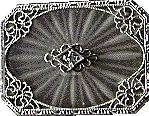 CAMPHOR GLASS Camphor glass is cloudy white glass that is either blown or pressed. Camphor glass was very popular in the mid-nineteenth century and used for jewelry, candlesticks, vases, dishes, barometers, and other pieces. Camphor glass jewelry imitates rock crystal. |
CANARY DIAMOND Canary diamonds are diamonds that have a deep yellow color. Diamonds are precious, lustrous gemstones made of highly-compressed carbon; they are one of the hardest materials known. Diamonds have a hardness of 10, a specific gravity of 3.5, and a refractive index of 2.417 - 2.419. |
CAPE AMETHYST Cape amethyst is a form of amethyst that is layered or striped with milky quartz. Cape amethyst is a translucent gemstone that ranges from light- to medium-purple and has white bands. |
CAPE RUBY A Cape ruby is actually a pyrope garnet (and not a ruby at all). |
CARAT A carat (ct.) is a standard measure of weight used for gemstones. One carat weighs 0.2 gram (1/5 of a gram or 0.0007 ounce). A hundredth of a carat is called a point. The carat unit was introduced in 1907. |
CARBONADO A carbonardo is a rare type of opaque black diamond; they are not used for jewels, but for items like drilling bits and abrasive wheels. They were once thought to have been formed as a result of a comet impact 2 billion years ago, but this is no longer thought to be true. The largest diamond ever found was a carbonardo that weighed over half a kilogram. Carbonadoes are found in Bahia, Brazil, South America. Unlike other diamonds, carbonadoes are not found in a crystallized form - they are found in irregular or rounded fragments. Carbonadoes have a hardness of 10 and a specific gravity (density) of 3.1-3.3. Diamonds have a very hard polycrystalline carbon structure. |
CARBUNCLE A carbuncle is a cabochon-cut garnet. |
CARNEGIE Hattie Carnegie was a clothing and jewelry designer who produced many beautiful costume jewelry pieces, including many figurals. Carnegie (nee Henrietta Kanengeiser) was born in 1886 in Vienna, Austria but moved to New York City, NY, USA around the turn of the century. She later opened a chain of high-priced boutiques and founded Hattie Carnegie, Inc. Carnegie jewelry is collected by many people and is marked Carnegie, Hattie Carnegie, of HC within a diamond and a half oval. The Carnegie mark was first used in January, 1919. Carnegie also designed hair jewelry, shoe buckles, and jeweled cases, which were sold with the marks "Pooped Pussy Cat" and "Pooped Poodle." |
 CARNELIAN Carnelian (also called cornelian and carneole) is a reddish form of chalcedony (a type of quartz). This translucent stone has a waxy luster. The best carnelian is from India. Most commercial carnelian is really stained chalcedony. Carnelian has a hardness of 7 and a specific gravity of 2.61. |
CASTLECLIFF Castlecliff was a mark used by the Castlecliff Jewelry, Inc., New York, NY, USA. This costume jewelry company was founded by Clifford Furst in 1945 and was in business nutil the 1970's. |
CASTELLANI, FORTUNATO Fortunato Castellani (1793-1865) was an Italian jewelry whose work revived the early Etruscan style of jewelry. His beautifully-made pieces had intricate workmanship including the ancient Etruscan art of granulation and carved gemstones. Castellani's sons carried on his work. |
CASTING Casting is the process in which metal is shaped by melting it and pouring it into a mold. This process has been used for thousands of years. Molds are made from many materials, including plaster compounds. Some different methods of casting include the lost wax process, centrifugal (or investment) casting, and sand casting. |
CATAMORE Catamore Enterprises was a costume jewelry company in operation from about 1942 to 1981. This large, family-owned business was located in Providence, Rhode Island. Their jewelry was sold through Sears, Roebuck and Co., JC Penney Co., Zale Corp., and other stores. Catamore won a landmark court case against IBM in 1975 for breech of promise in a computer services contract. Catamore was bought by a London firm in 1981. Catamore pieces are marked CATAMORE or John Grant Designs (this mark was first used in 1970). Jewelry by Catamore was often gold filled in 12 karat gold (marked 1/20 12kgf.) or steling silver. Many were decorated with rhinestones, cameos, or onyx. |
 CATHEDRAL SETTING A cathedral ring setting is a simple band that arches when seen from the side (like the arches of a cathedral). |
CAT'S EYE CHRYSOBERYL Cat's eye (chatoyant chrysoberyl) is a yellow to green-yellow to gray-green stone with a bright, pupil-like slit that seems to move slightly as the stone is moved. Most Cat's eye is cut as cabochons to maximize the distinctive pupil-like effect. Most cat's eye chrysoberyl is found in Brazil. Cat's eye chrysoberyl has a hardness of 8.5. This stone is sometimes enhanced by irradiation (this process improves the color and accentuates the stone's asterism). |
CAVINESS, ALICE Alice Caviness (-1983) was a clothing and costume jewelry designer who produced high-quality pieces. She began producing pieces in the late 1940's (after World War 2) and her company is still in operation, now headed by Caviness' business partner, Lois Stein. The company is located in Malverne, Long Island, New York. |
CELLINI, BENVENUTO Benvenuto Cellini (1500-1571) was the pre-eminent Italian jeweler during the renaissance. Cellini's intricate works utilized beautifully-cast metals, enamel, table-cut gems, and pearls. |
CELEBRITY Celebrity is a mark of generally low- to medium-quality costume jewelry made by a New York company. The trademark "Celebrity" is owned by the Celebrity Jewelry Company of Philadelphia, Pennsylvania, which makes jewelry of gold and silver, with precious stones. |
CELLULOID Celluloid is a plastic made from cellulose (derived from plants). This very flammable material was invented in 1869 by the American inventor John Wesley Hyatt (it was invented to be a substitute for the elephant ivory used for billiard balls). Celluloid was one the first plastics invented; it can be damaged by moisture. |
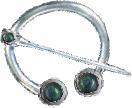 CELTIC JEWELRY Celtic jewelry was made by the Celts in Ireland, Wales, Scotland, and Brittany. The Celts used bronze, silver and gold in their jewelry and stones like cairngorm and amethyst. Circular brooches with a long, hinged pin, called penannular brooches, date from ancient times. The earliest-known piece of Celtic jewelry is the Hunterston brooch from A.D. 700 |
CFW CFW is an abbreviation for cultured freshwater pearls. |
CHALCEDONY Chalcedony is a family of minerals (microcrystalline quartz) that are often milky to gray to bluish in color. Chalcedony includes agate, carnelian (waxy red), chalcedony (blue), chrysoprase (green), onyx (black and white), bloodstone, sard (brownish-red), jasper (hornstone), seftonite, and others. Chalcedony is porous and translucent. Chalcedony has a hardness of 6.5-7 and a specific gravity of 2.6. |
CHAMPAGNE DIAMOND A champagne diamond is a pinkish brown diamond (having a color of C2-C3). Most champagne diamonds are mined in Western Australia (in the Argyle Mine). The color is produced by a their low nitrogen content. |
CHAMPLEVÉ (meaning sunken enamel) Champlevé (also called email champlevé) is a method of applying enamel to metal in which the design is first outlined on the metal surface by cutting lines into the surface. The engraved grooves are then filled with enamel, then fired to a glassy sheen, and polished. Champlevé is similar to cloisonné, but not as delicate. |
CHANNEL SET Channel set jewels rest in a metal channel, held in only by a slight rim which runs along the edges of the channel. Channel set jewels are usually round or baguette shaped. |
CHAREL Charel is a mark of relatively rare, medium-quality costume jewelry made by the Charel Jewelry Company, Inc. of Brooklyn, New York. Many Charel pieces have pastel-colored plastic stones on plated metal. |
CHARM Charms are tiny, representational ornaments that are worn on bracelets and necklaces. |
CHAROITE Charoite is a very rare, bright purple mineral used as a gemstone. This silicate is only found in Russia (at the Chary River at Aldan). Charoite is transparent to translucent and has a hardness of 5. |
CHASING Chasing is a type of metal decoration in which the metal is manipulated using a hammer and a punch, resulting in an effect similar to engraving or embossing. |
CHATHAM SYNTHETIC RUBY Chatham synthetic rubies (laboratory-created rubies) were introduced by Carroll Chatham in 1959. |
CHATELAINE A Chatelaine is a set of household tools each attached to a chain and usually worn at the waist. Chatelaine tools frequently included scissors, a needle holder, thimble, vinaigrette, pin cushion, etui/necessaire, writing tablet, pencil, perfume bottle, seal, boot hook, etc. |
CHATON A chaton is a stone with a reflective metal foil backing. |
CHÂTON SETTING A châton setting (also called coronet or arcade setting) is one in which the stone is held in by many metal claws around a metal ring. |
 CHATOYANCY Chatoyancy is the lustrous, cat's eye effect seen in some cabochon stones, like cat's eye, tiger's eye (pictured above), and sometimes in other stones, like aquamarine. In chatoyancy, light is reflected in thin bands within the stone. Chatoyant stones are cut in cabochon to maximize the lustrous effect. |
CHENIER Chenier is fine, hollow tubing that is used in the production of some jewelry findings (like clasps and joints), and lately, in the actual production of jewelry. The hollow tubes are lightweight and save in the use of gold. The tubes are hard to bend when they are empty, so a metal rod is inserted before bending, facilitating the bending. |
CHINESE OPAL Chinese opal is a misnomer for pearl opal (a type of organic opal), moonstone, or white chalcedony. |
CHOKER A choker is a type of necklace that fits tightly around the neck. Chokers are from 14" to 16" in length. |
CHROME DIOPSIDE Chrome diopside is an emerald-green colored gemstone. It is a chromium-rich variety of the common mineral diopside (Calcium magnesium silicate). Chrome diopside has a hardness of 5 to 6 and a specific gravity of 3.3 to 3.6. |
CHROMIUM Chromium is a hard, shiny, gray-white metal. This metal resists corrosion very well and is used in costume jewelry as a coating over other metals. |
CHRONOGRAPH A chronograph is a stopwatch mechanism on a watch; it can be started, stopped and reset independently from the watch. |
CHRYSOBERYL Chrysoberyl is a hard stone that ranges in color from yellow, to brown, to green. Some chrysoberyls include alexandrite and cat's eye. |
CHRYSOCOLLA Chrysocolla (meaning "golden lime" in Greek) is an opaque blue to blue-green mineral sometimes used in jewelry. It is usually cut as a cabochon. Chrysocolla (hydrated copper silicate) is found embedded in rock crystal in copper mines in the USA, Russia, Chile, and the Congo. Although Chrysocolla has been used in ornaments since the time of the ancient Greeks, it was only described mineralogically in 1968. Its hardness varies from 2 to 4. |
 CHRYSOLITE Chrysolite is a name used for many stones. During Victorian and Edwardian time, it referred to green-yellow chrysoberyl. It can also refer to peridot (shown above). Long ago, the name was used to refer to almost any yellowish gem. |
CHRYSOPRASE Chrysoprase is the most valued variety of the mineral chalcedony (microcrystalline quartz) that contains nickel, giving it an apple-green color. Chrysoprase is porous and translucent. It is usually cut as a cabichon, and has been used since ancient times. Chrysoprase has a hardness of 7 and a specific gravity of 2.6. Chrysoprase is mined in Australia, Russia (the Ural Mtns.), Brazil, and the western USA. Chrysoprase is sometimes called "Australian jade," but it is not related to jade. Hard-to-detect imitation chrysoprase is made by staining agate with chromium salts. |
 CINER Ciner is a jewelry complany that was founded in 1895 by Emanuel Ciner, originally producing fine jewelry. Since 1931, Ciner began producing high-end costume jewelry with very good quality stones (including Swarovski rhinestones) and 18-carat gold plated finishes. Their "pearls" are specially made by coating glass beads with pearl luster many times. Many Ciner pieces have a multitude of tiny, good-quality stones. The starfish pin above has jade-colored stones and pavé rhinestones. |
 CINNABAR Cinnabar is the mineral Mercury Sulfide. Its color ranges from cinnamon to scarlet to brick red and it can be translucent to transparent. It is often carved. Cinnabar has a hardness of 2 - 2.5 (very soft) and a specific gravity of 8.1 (quite heavy). |
 CINI Cini produces jewelry made of silver and gold-plated silver (vermeil), some with colored rhinestones (in later pieces). Cini pieces are known for their beautiful workmanship, artistic designs, and intricate detail. The company was formed by Guglielmo Cini, who was trained as a jeweler in Florence, Italy, and emigrated to the USA in 1922. He made jewelry in Boston, Massachusetts but moved to Laguna Beach, California, in 1957. The company went out of business in 1970, but has been reopened by the Cini grandaughters, Amy and Molly. The vintage silver lion pin above is by Cini. |
CIRE PERDU Cire perdu (French for "lost wax") is a process of casting metal in which the original model is sculpted in wax. The wax is entombed in clay, and the wax is then melted out, producing a hollow mold. The mold is then filled with molten metal. The clay is broken off and the cast metal remains. |
CITRINE Citrine (from the French for "lemon") is a rare, yellow type of quartz, a semi-precious stone that ranges in color from pale yellow to orange to golden brown. The best quality citrine is found in Brazil. Many of the stones sold as citrine are actually heat-treated amethysts. Citrine has a hardness of 7 and a specific gravity of 2.65. |
CLASP A clasp is a fastener that can open and close, attaching two things together (for example, the two ends of a necklace, or a pin to a garment). The clasp on a piece of jewelry can tell you a lot about the piece, including giving an indication of its age (by determining when that particular type of clasp was invented and looling at the wear on the clasp), its quality (better quality pieces generally have better-quality clasps), and its composition and manufacturer (the clasp is often where the maker's stamps are). For example, the spring ring clasp was invented early in the 1900's; jewelry made prior to 1900 or so will not have a spring ring clasp. Some other common clasps include the lobster claw clasp, the box clasp, the barrel clasp, the fold-over clasp, the hook-and-eye clasp, and the bar and ring toggle clasp. |
CLOUD A cloud is a type of inclusion in some gemstones that has a milky appearance (and greatly affects the value of the stone). A cloud is usually composed of a cluster of tiny inclusions. |
 CLUSTER SETTING A cluster setting is one in which small stones or pearls are set around a larger stone. |
COGNAC DIAMOND A cognac diamond is a cognac-brown diamond (having a color of C7). Most cognac diamonds are mined in Western Australia (in the Argyle Mine). The color is produced by a their low nitrogen content. |
COLLET SETTING A collet setting is a very early method of setting gemstones. A collet is a thin, round band of metal that goes all around the stone. One edge of the metal is crimped over the edges of the stone and the other edge is soldered to the metal of the jewelry, holding the stone in place. This closed setting sometimes also had metal claws along the outside to hold the stone even more securely (the claws were not used much after the 1200's and 1300's. |
COLLARETTE A collarette (also known as a bib necklace) is a short necklace with flowing ornaments at the front. |
COLORADO RUBY A Colorado ruby is actually a pyrope garnet (and not a ruby at all). |
COMPOSITE SUITE A composite suite is a piece of jewelry that can be taken apart into two or more pieces which can also be worn. For example, a necklace may be disassembled into two bracelets. |
CONCH Conch is a marine animal (a mollusk) with a large, beautiful pearly shell that varies in color, but if often white or pink (pink is the most valued color). Queen conch has a large, pink shell. Conch shell is often used to make jewelry. Conch is made into beads and cameos. Conch has a hardness of 2.85 (it is relatively soft). |
CONCHA A concha is a hammered silver disk or oval that often resembles a shell, flower, or sunburst. Conchas often have raised designs (repoussage). Conchas are traditionally used to decorate belts (a series of conchas are attached to a leather belt), bridles, and other items. Concha is the Spanish word for conch shell. |
 CONFETTI LUCITE Confetti lucite is transparent plastic with glitter or other small pieces of material within it. Whimsical bangles, earrings, pins, necklaces and other jewelry have been made from confetti lucite. |
CONTINENTAL Continental was a Canadian costume jewelry company that produced good-quality pieces, usually studded with colorful rhinestones. |
CONTRA LUZ OPAL Contra luz (also spelled contraluz) opals are transparent opals that show a brilliant play of iridescence only when light shines through the stone. When the light is on the same side as the viewer, the iridescence is not readily seen (this quality makes it difficult to design jewelry using these beautiful gemstones). Contra luz means "against the light." Unlike other opals, contra luz opals are usually faceted (rather than cabochoned). |
 COPPER Copper is a soft metal often used in jewelry. It is used in making bronze, brass, and gold alloys. The enameled copper leaf pin above is marked Matisse, from the "Renoir of California" jewelry company. |
 CORAL Coral is an animal that grows in colonies in the ocean. Coral polyps secrete a strong calcium structure that is used in jewelry making. Coral ranges in color from pale pink (called angelskin coral) to orange to red to white to black. The most valued colors are deep red (called noble coral) and pink. In jewelry making, coral is either carved into beads, cameos, or other forms, or is left in its natural branch-like form and just polished. It used to be thought that coral protected the wearer, so it was a traditional gift to children. Coral has a hardness of about 3.5 and a specific gravity of 2.6 to 2.7. Since it is composed of calcium carbonate, coral will effervesce if touched with acid. Imitation coral is made from glass, porcelain, or plastic. |
 CORNELIAN Cornelian (also called carnelian and carneole) is a reddish form of chalcedony (a type of quartz). This translucent stone has a waxy luster. The best carnelian is from India. Most commercial carnelian is really stained chalcedony. Carnelian has a hardness of 7 and a specific gravity of 2.61. |
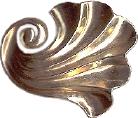 CORNUCOPIA The cornucopia is a symbol of plenty and is used sometimes in jewelry. The Trifari cornucopia pin/clip pictured above is gold colored. It has a double-pronged fastening mechanism that can be used either as a fur clip or as a pin. |
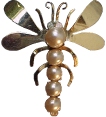 CORO Coro, Inc. is the largest costume jewelry company. It was founded by Cohn and Rosenberger early in 1919, producing reasonably-priced jewelry. Many Coro pieces are avidly collected, including their duettes, sterling pieces, and many intricate older pieces. |
 CORO DUETTES Coro duettes are patented sets of jewelry made by the Coro company. Each "duette" has two clips which attach to a pin base; they can be worn as a single pin or as two clips. |
CORONET SETTING A coronet setting (also called châton or arcade setting) is one in which the stone is held in by many metal claws around a metal ring. |
CORUNDUM Corundum is a very hard mineral (hardness 9); only diamond is harder. Corundum is called ruby or sapphire, depending on the color (which depends on which metallic oxides are present). In its rare pure form, corundum is colorless and called white sapphire. Rubies contain chromic oxide, blue sapphires contain titanium, yellow sapphires contain ferric oxide. Other impure forms are opaque. Corundum stones can produce beautiful asterisms. The word corundum comes from the Tamil word for ruby. Corundum has a specific gravity of 3.96-4.01. |
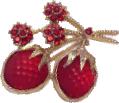 COVENTRY Sarah Coventry is a company that produced mid-range costume jewelry. The Sarah Coventry jewelry company was founded in Newark, New York, USA in November, 1948, by Charles H. Stuart (who had earlier founded the Emmons jewelry company). He named the company after his his grand-daughter. Sarah Coventry jewelry was sold at home fashion shows until 1984, when the company was sold. Both women's and men's jewelry was produced under the marks Sarah Coventry (first used in May, 1949), SC (first used in Oct. 1953), Sarah Cov (first used in Jan. 1960). Sarah Coventry jewelry came with a "Lifetime Guarantee" which read, "May be sent back for repair to: P.O. Box 7899, Warwick, RI 02887. Please include handling charge of 1.50." |
CRIMP BEAD A crimp bead is a soft, metal bead through which string (for a bracelet or necklace) is threaded; the crimp bead can be squeezed shut with a pliers to secure the end loops of the threading material fasteners onto the clasps. |
CROWN The crown is the upper part of a gemstone. |
CROWN GLASS Crown glass is glass that contains no lead oxide. Some fake rhinestones are made from crown glass. |
CRYSTAL (GLASS) Crystal is high-quality glass containing at least 10% lead oxide. Lead added to the melt produces very clear glass resembling rock crystal. The process of making lead crystal was discovered by the English glassmaker George Ravenscroft in 1676. Crystal is colored by adding various metallic oxides to the melt. |
CRYSTAL (NATURAL) A crystal is a solid whose atoms form a very regular structure. Some crystals include quartz, diamond, and emerald. |
 CRYSTAL HABIT Crystal habit is the crystal form that a particular crystal has. The most common crystal habits are: |
 CRYSTAL SYSTEMS Crystals are divided into seven crystal systems, according to their optical properties (how light bends within the crystal), plane of symmetry, axis of symmetry, center of symmetry, crystallographic axis. Within each of the systems, the cyrstals can mineralize into different crystal habits (form). The seven crystal systems are: cubic systems, tetragonal systems, hexagonal systems, trigonal systems, orthorhombic systems, monoclinic systems, and triclinic systems. For more information on crystal systems, click here. |
CUBIC ZIRCONIUM Cubic zirconium (also known as cubic zirconia) is an inexpensive, lab-produced gemstone that resembles a diamond. Cubic zirconia was developed in 1977. |
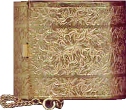 CUFF BRACELET A cuff bracelet is a stiff, relatively wide bracelet. The gold-toned, hinged cuff above is by the jewelry designer Miriam Haskell. |
CUFFLINKS Cufflinks are men's jewelry that close the buttonholes of the cuff of a long-sleeved shirt. Some cufflinks are basically two button-like objects connected by a chain; the bottons go through the cufff's buttonholes. Another type of cufflink has a decorative button attached to a stick whose end swivels out to form a T-shape that goes through the buttonhole. Cufflinks were first worn in the 1800's. |
CULET A culet is the bottom point of a gemstone or a small facet that is ground at the base of a brilliant-cut gemstone. The culet prevents splintering of the stone. Modern stones rarely have a faceted culet. |
CULLINAN DIAMOND The Cullinan diamond (also called the Star of Africa) is the largest diamond yet found, weighing 3,106 carats (roughly 1.3 pounds) in its rough form. It was mined at the Premier Mine in South Africa in 1905. This enormous gem was named for the chairman of the company that owned the mine. It was given to King Edward VII of England for his birthday in 1907. The diamond was cut (by Joseph J. Asscher of Amsterdam) into many stones, including the Cullinan I (530 carats, pendelique-brilliant shaped, the largest cut diamond in the world), the Cullinan II (317 carats, cushion shaped), Cullinan III (94 carats, pendelique shaped), Cullinan IV (63 carats, square-brilliant shaped), and many other smaller stones. |
CULTURED PEARL Cultured pearls are pearls produced by oysters that have been surgically injected (nucleated) with bits of mussel shell. After 5-7 years, the oysters are retrieved and the pearls are harvested. This method of "manufacturing" pearls was invented in 1893 by Kokichi Mikimoto. |
 CUPID'S DARTS Cupid's Darts is another name for rutilated quartz. |
CUSHION CUT Cushion cut stones are shaped like a cushion - they have a squarish shape that is rounded on the edges. These stones usually have facets similar to those of a brilliant cut stone. |
CUT BEADS Cut beads are glass beads that have been faceted. This process makes the bead reflect and refract more light. |
 CUT STEEL Cut steel is steel that is cut with a huge number of facets and then riveted to a plate of steel (or other metal). It was widely used in jewelry during the late 18th century, including shoe buckles, buttons, bracelet, necklaces, earrings, hair ornaments, and as a setting for cameos. Early in the 19th century, cut steel quality diminished and was stamped out in strips instead of being individually cut and riveted. |
CUT STONES Common cuts include the brilliant cut, old European cut, emerald cut, radiant cut, rose cut, step cut, pendelique cut. Mixed cuts in which the style of the facets above and below the girdle are different. Other, more unusual cuts, are know as fantasy cuts (like the heart cut). |
Illustrated Dictionary of Jewelry |
 |
||||||
| A | B | C | D | E | F | G | H | I | J | K | L | M | N | O | P | Q | R | S | T | U | V | W | X | Y | Z |
Enchanted Learning®
Over 35,000 Web Pages
Sample Pages for Prospective Subscribers, or click below
|
Overview of Site What's New Enchanted Learning Home Monthly Activity Calendar Books to Print Site Index K-3 Crafts K-3 Themes Little Explorers Picture dictionary PreK/K Activities Rebus Rhymes Stories Writing Cloze Activities Essay Topics Newspaper Writing Activities Parts of Speech Fiction The Test of Time
|
Biology Animal Printouts Biology Label Printouts Biomes Birds Butterflies Dinosaurs Food Chain Human Anatomy Mammals Plants Rainforests Sharks Whales Physical Sciences: K-12 Astronomy The Earth Geology Hurricanes Landforms Oceans Tsunami Volcano |
Languages Dutch French German Italian Japanese (Romaji) Portuguese Spanish Swedish Geography/History Explorers Flags Geography Inventors US History Other Topics Art and Artists Calendars College Finder Crafts Graphic Organizers Label Me! Printouts Math Music Word Wheels |
Click to read our Privacy Policy
| Search the Enchanted Learning website for: |